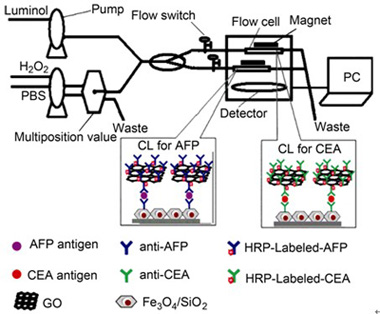[1] Yonemori, K.; Ando, M.; Shibata, T.; Katsumata, N.; Matsumoto, K.; Yamanaka, Y.; Kouno, T.; Shimizu, C.; Fujiwara, Y. J. Cancer Res. Clin. Oncol. 2006, 132(10), 635.
[2] Smith, R. A.; Cokkinides, V.; von Eschenbach, A. C.; Levin, B.; Cohen, C.; Runowicz, C. D.; Sener, S.; Saslow, D.; Eyre, H. J. CA Cancer J. Clin. 2002, 52(1), 8.
[3] Li, C. H. Chin. J. Laboratory Med. 2000, 23(1), 6. (李春海, 中华检验医学杂志, 2000, 23(1), 6.)
[4] Sun, X. L.; Chu, J. G.; Chen, P. Z.; Yang, H. Y.; Dai, Y. Labeled Immunoassays and Clinical Medicine 2001, 8(3), 160. (孙晓丽, 褚建国, 陈泮藻, 杨航燕, 戴雨, 标记免疫分析与临床, 2001, 8(3), 160).
[5] Nunez, E. A. Tumor Biol. 1994, 15(2), 63.
[6] Dudich, E.; Semenkova, L.; Gorbatova, E.; Dudich, I.; Khromykh, L.; Tatulov, E.; Grechko, G.; Sukhikh, G. Tumor Biol. 1998, 19(1), 30.
[7] Wang, X. W.; Xie, H. Life Sci. 1999, 4(1), 17.
[8] Li, M. S.; Li, P. F.; He, S. P.; Du, G. G.; Li, G. World J. Gastroenterol. 2002, 8(3), 469.
[9] Castaldi, F.; Marino, M.; Beneduce, L.; Belluco, C.; De Marchi, F.; Mammano, E.; Nitti, D.; Lise, M.; Fassina, G. Int. J. Biol. Markers 2005, 20(4), 204.
[10] Sorbye, H.; Dahl, O. J. Clin. Oncol. 2003, 21(23), 4466.
[11] Zhang, L. M. Basic Clinical Medicine 1995, 15(4), 247. (张丽民, 基础医学与临床, 1995, 15(4), 247.)
[12] Lin, J. H.; Ju, H. X. Biosens. Bioelectron. 2005, 20, 1461.
[13] Zhou, Y.; Zhang, Y. H.; Lau, C. W.; Lu, J. Z. Anal. Chem. 2006, 78, 5920.
[14] Fu, Z. F.; Hao, C.; Fei, X. Q.; Ju, H. X. J. Immunol. Methods 2006, 312, 61.
[15] Bidlingmaier, M.; Suhr, J.; Ernst, A.; Wu, Z.; Keller, A.; Strasburger, C. J.; Bergmann, A. Clin. Chem. 2009, 55(3), 445.
[16] Du, D.; Wang, L. M.; Shao, Y. Y.; Wang, J.; Engelhard, M. H.; Lin, Y. H. Anal. Chem. 2011, 83(3), 746.
[17] Lin, J. H.; Zhang, H.; Mei, Z. H.; Hu, K. C. Chin. J. Anal. Chem. 2010, 38, 924. (林洁华, 张慧, 梅振华, 胡孔诚, 分析化学, 2010, 38, 924.)
[18] Lin, J. H.; Chu, P. F.; Wei, Z. J. Anal. Sci. 2012, 28(1), 21.
[19] Fu, Z. F.; Yang, Z. J.; Tang, J. H.; Liu, H.; Yan, F.; Ju, H. X. Anal. Chem. 2007, 79, 7376.
[20] Xia, Q. F.; Luo, D.; Li, Z. J. Acta Chim. Sinica 2012, 70, 2079. (夏前芳, 罗丹, 李在均, 化学学报, 2012, 70, 2079.)
[21] Lin, J. H.; Wei, Z. J.; Mao, C. M. Biosens. Bioelectron. 2011, 29, 40.Lin, J. H.; Wei, Z. J.; Chu, P. F. Anal. Biochem. 2012, 421, 97.


